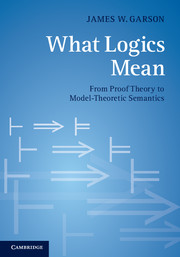Book contents
- Frontmatter
- Dedication
- Contents
- Preface
- Acknowledgements
- 1 Introduction to model-theoretic inferentialism
- 2 Deductive expression
- 3 Local expression
- 4 Global expression
- 5 Intuitionistic semantics
- 6 Conditionals
- 7 Disjunction
- 8 Negation
- 9 Supervaluations and natural semantics
- 10 Natural semantics for an open future
- 11 The expressive power of sequent calculi
- 12 Soundness and completeness for natural semantics
- 13 Connections with proof-theoretic semantics
- 14 Quantifiers
- 15 The natural semantics of vagueness (with Joshua D. K. Brown)
- 16 Modal logic
- Summary
- References
- Index
1 - Introduction to model-theoretic inferentialism
Published online by Cambridge University Press: 05 June 2014
- Frontmatter
- Dedication
- Contents
- Preface
- Acknowledgements
- 1 Introduction to model-theoretic inferentialism
- 2 Deductive expression
- 3 Local expression
- 4 Global expression
- 5 Intuitionistic semantics
- 6 Conditionals
- 7 Disjunction
- 8 Negation
- 9 Supervaluations and natural semantics
- 10 Natural semantics for an open future
- 11 The expressive power of sequent calculi
- 12 Soundness and completeness for natural semantics
- 13 Connections with proof-theoretic semantics
- 14 Quantifiers
- 15 The natural semantics of vagueness (with Joshua D. K. Brown)
- 16 Modal logic
- Summary
- References
- Index
Summary
The purpose of this book is to explore what rules of logic express about the meanings of the logical symbols they govern. Suppose that the only thing you know about the symbol ‘*’ is that the following rules govern its behavior. Given an English sentence of the form A*B, it follows that A, and it also follows that B. Given A and B together, it follows that A*B. Can you tell what the symbol ‘*’ means? Did you think that ‘*’ must mean what we mean by ‘and’ in English, and that the truth behavior of sentences involving ‘*’ must conform to the standard truth table for conjunction? If you did, can you be certain that the same deductive role for ‘*’ specified by these rules might not also allow some alternative (or unintended) interpretation for ‘*’?
The broader picture
Questions like this are special cases of a general concern in the philosophy of language. To what extent can the meanings of expressions of a language be defined by the roles they play in our reasoning? Does knowing the meaning of a sentence simply amount to knowledge of which sentences entail it and which ones it entails? Would it be possible at least in principle for alien anthropologists from a planet circling the star Alpha Centauri (who know initially nothing about our language) to learn what our sentences mean by simply investigating the way we reason from one to another in different circumstances?
- Type
- Chapter
- Information
- What Logics MeanFrom Proof Theory to Model-Theoretic Semantics, pp. 1 - 24Publisher: Cambridge University PressPrint publication year: 2013



